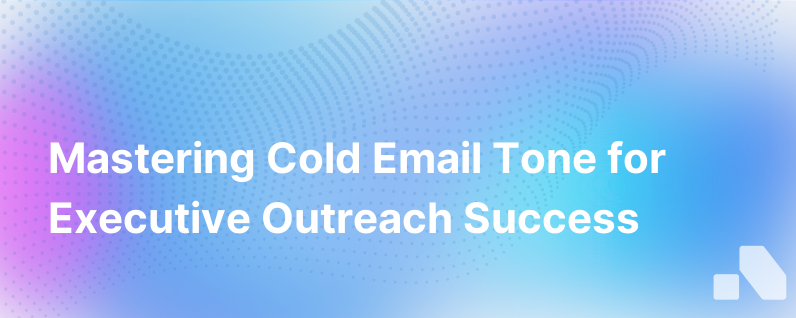
In the era of instant messaging and social media, the art of email communication remains king in the business world, especially when it comes to cold outreach. The initial email you send to a prospective client or partner can often make or break a future relationship. Crafting the perfect cold email is a delicate balance. The tone of your message is so crucial that it can charm and engage or, alternatively, repel and disengage your recipients.
In an age where email inboxes are battlegrounds, cluttered with promotions, updates, and a barrage of other unsolicited messages, standing out is both an art and a science. As a professional well-versed in this modern-day challenge, I have discovered several vital tone tips that can help transform your cold emailing endeavors.
1. Warmth Over Coldness
Despite the label 'cold email', your message should convey warmth. A friendly, relatable approach will always outperform a sterile, corporate tone. Begin with a personalized greeting and possibly a shared reference or a compliment about their recent work or company achievement. Demonstrate that you view your recipient as a distinct individual, not just a target in a mass mailing campaign.
2. Conciseness is Key
Time is a scarce commodity. Your email should be succinct yet sufficient to convey your key messages. Cut the fluff, get to the point, but ensure that your tone doesn’t come across as brusque. Aim for clarity and brevity without compromising on politeness or thoroughness.
3. Add a Human Touch
Injecting a dose of personality into your cold email can be the difference between a swift deletion and a second glance. Humor, tastefully and sparingly used, or a conversational style that mirrors face-to-face interaction can help build a connection. However, stay professional – colloquialisms and slang are best used sparingly and only if they suit the industry and audience you are targeting.
4. Confidence, Not Arrogance
There is a thin line between confidence and arrogance. While it’s absolutely vital to express confidence in the value that your product or service can deliver, it's equally essential to avoid overconfidence and arrogance. Using phrases such as “we believe” instead of “we know” strikes a balance of confidence tinged with humbleness, suggesting potential value without dismissing the recipient’s current strategies or solutions.
5. Curiosity Instead of Assumption
Pose questions rather than making assumptions about your recipient’s needs or challenges. This not only shows that you’re open to learning about them but also invites a dialogue. Inquiring about their challenges or views on an industry trend can be an excellent way to segue into how your offering might be of interest.
6. Respect and Professionalism
Always maintain a respectful tone. Whether it's addressing them by their preferred title or ensuring you’ve spelt their name correctly, these details matter and demonstrate professionalism and respect. This includes acknowledging the intrusion inherent in cold emailing and thanking them in advance for their time or consideration.
7. Use Active Voice
The active voice naturally holds a more direct and engaging tone than passive constructions. It also often leads to clearer, concise sentences. For example, "We have designed our software to resolve your customer service challenges" is more engaging than "Your customer service challenges can be resolved by software we have designed."
8. Offer Value before Seeking Gain
The primary focus of your initial email should be what you can offer, not what you hope to gain. Center your message around the recipient – use 'you' more than 'we/I.' Describe benefits instead of features, tell them what's in it for them, and if possible, provide something of immediate value, such as a free resource or useful insight.
9. Avoid Jargon and Complex Terminology
Use plain language that doesn’t gatekeep or confuse. Industry jargon, buzzwords, and overly technical language can alienate a recipient. Even if you’re reaching out to an industry insider, straightforward language shows you can communicate effectively without hiding behind complex terminology.
10. Professional But Personable Sign-off
Your sign-off is the last impression you leave with the recipient. Friendly yet professional sign-offs can go a long way. Instead of a cold “Regards,” consider “Best regards,” “Sincerely,” or “Looking forward to hearing from you.”
11. The Follow-Up
Sending a follow-up email a week or two later can be an effective way to show your commitment and interest. The tone here should be as polite and considerate as in the initial email, taking into account that the recipient may have missed your first message or been too busy to respond.
Conclusion
Crafting the perfect cold email is indeed a task that calls for finesse and keen attention to tone. While these tips offer guidance to help structure your outreach, each communication must be customized to your unique recipient for true effectiveness.
Remember, the goal of a cold email isn’t necessarily to close a deal after one exchange. It's about opening a line of communication, building rapport, and providing value. The ultimate aim is to begin a conversation that could lead down the path to a successful partnership or sale.
In the world of cold email marketing, where Aomni comes into play, is through real-time account research and competitive insights that help personalize and enhance the relevance and impact of your message. Tailored content, created quickly and seamlessly, gives you that extra edge—a crucial factor in today's saturated marketplace. By employing these cold email tone tips in combination with cutting-edge tools like Aomni, you can elevate your outreach strategy and forge more meaningful connections with your prospects.